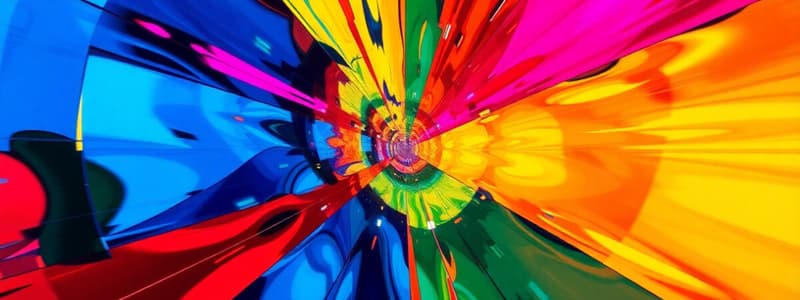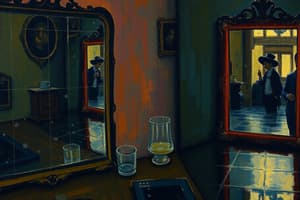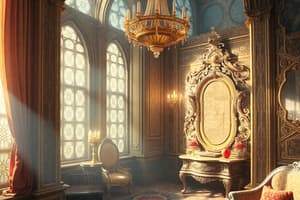Podcast
Questions and Answers
A plane mirror is created by coating the back of a flat glass piece with a shiny material.
A plane mirror is created by coating the back of a flat glass piece with a shiny material.
True (A)
The reflection of light from a mirror is always irregular reflecting.
The reflection of light from a mirror is always irregular reflecting.
False (B)
The image formed by a plane mirror is always the same size as the object.
The image formed by a plane mirror is always the same size as the object.
True (A)
A plane mirror is only useful for seeing oneself.
A plane mirror is only useful for seeing oneself.
Before Justus von Liebig's invention, mirrors were made by polishing a piece of metal.
Before Justus von Liebig's invention, mirrors were made by polishing a piece of metal.
Why does a plane mirror always create an image of the same size as the object?
Why does a plane mirror always create an image of the same size as the object?
Why is the image formed by a plane mirror called a virtual image?
Why is the image formed by a plane mirror called a virtual image?
Which of the following best describes the concept of lateral inversion in a plane mirror?
Which of the following best describes the concept of lateral inversion in a plane mirror?
Why do the reflected rays from a point source appear to originate from a point behind the mirror?
Why do the reflected rays from a point source appear to originate from a point behind the mirror?
How is an image of an extended source formed by a plane mirror?
How is an image of an extended source formed by a plane mirror?
Flashcards
Reflection of Light
Reflection of Light
The bouncing back of light when it hits a surface.
Types of Reflection
Types of Reflection
Regular reflection occurs on smooth surfaces; irregular on rough surfaces.
Plane Mirror
Plane Mirror
A flat mirror that reflects light, producing an image the same size as the object.
Construction of Plane Mirrors
Construction of Plane Mirrors
Signup and view all the flashcards
Justus von Liebig
Justus von Liebig
Signup and view all the flashcards
Image Formation in Mirrors
Image Formation in Mirrors
Signup and view all the flashcards
Virtual Image
Virtual Image
Signup and view all the flashcards
Perpendicular Reflection
Perpendicular Reflection
Signup and view all the flashcards
Size of Images
Size of Images
Signup and view all the flashcards
Lateral Inversion
Lateral Inversion
Signup and view all the flashcards
Study Notes
Light and Reflection
- Light is an agent that provides information about surroundings
- Light enables us to see natural wonders like sunrise, flowers, and stars
- Light is electromagnetic radiation, which causes the sensation of vision
- Light reflects differently from various surfaces
- Smooth, flat surfaces cause regular reflection
- Rough surfaces cause irregular reflection
Mirrors and Types
- Mirrors are polished surfaces that reflect light
- Polished surfaces absorb less light, resulting in maximum reflection
- A surface that reflects light and creates clear images is called a mirror
- Mirrors are used in daily life
Types of Mirrors
- Mirrors come in two types:
- Plane mirrors
- Used in everyday activities like seeing our reflection
- Spherical mirrors
- Plane mirrors
Plane Mirrors
- They are flat and smooth glass pieces coated with a reflective film (aluminium or silver)
History of Mirrors
- Justus von Liebig, a German scientist, coated a piece of ordinary glass with silver metal, creating the first mirror (called a silvered glass mirror)
- A reflecting film of aluminum or silver is put onto the back of a glass piece.
- To protect the film, another coating of lead oxide is given over it.
Studying That Suits You
Use AI to generate personalized quizzes and flashcards to suit your learning preferences.




